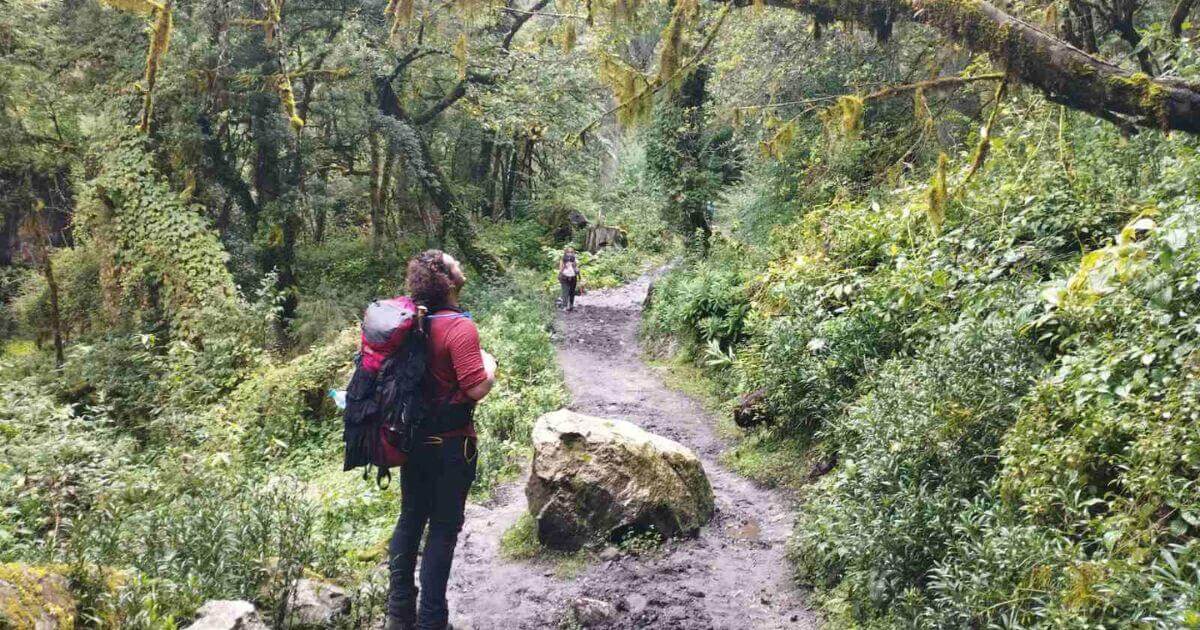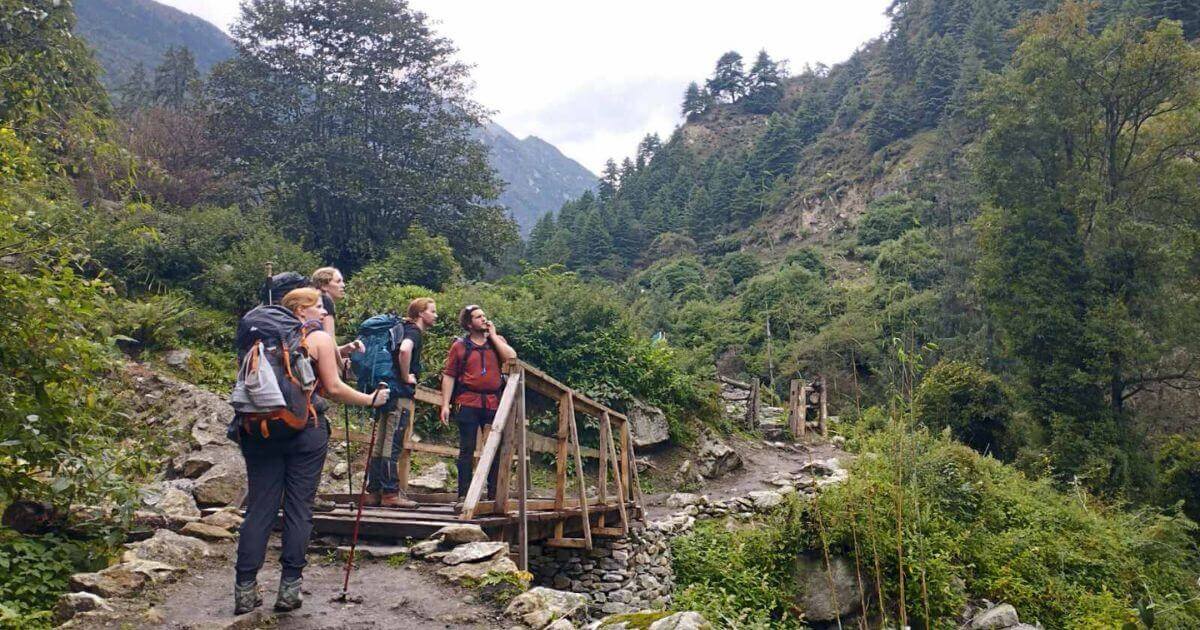10 Amazing Health Benefits Of Trekking

10 Nov 2022 Chandra Gurung
The majority of us are aware that we should exercise more. Still, because our lives are getting busier, it’s critical to prioritize the activities that will improve our health the most. It’s not pleasant to work out in a gym after spending the day at a desk in a stuffy office. As we know there are lots of health benefits to trekking.
It’s hardly surprising that an increasing number of people choose to enhance their health by trekking instead of going to the gym. The good news is that walking or trekking for just 30 minutes a day can positively influence your health!
Do you need persuasion to put on your walking boots? The following list of ten health advantages of trekking may surprise you.
1. Survive Longer
According to studies, walking just 5 miles per week at a relaxed pace can significantly lower your risk of heart attacks, strokes, and heart failure by 31%. Ten thousand steps equal just 5 miles, so if you’re a Fitbit addict and find yourself walking around at night to hit that goal, congrats — you’re crushing it!
One of the most effective methods to reduce cancer risk is to be active. Exercise reduces the amount of estrogen in your blood, which is thought to explain why active women have a 30% decreased risk of breast cancer.
2. Make You Happier

To treat depression, doctors are increasingly recommending exercise like walking. Numerous clinical trials have demonstrated that exercise can reduce depressive symptoms to a degree comparable to antidepressant medication. Trekking is a great way to improve your mood since it combines the physical benefits of physical activity with the mental health advantages of being in nature and interacting with other hikers.
More and more research is demonstrating a connection between people’s mental health and the amount of time they spend outdoors. Spending time in nature has been shown in studies to reduce stress and blood pressure, enhance sleep quality, and increase energy.
3. Robust and Flexible Bones
Up-and-down walking on uneven ground increases the flexibility and agility of the leg muscles. Trekkers have lean, attractive legs that help to keep their ankles stable. The legs, core, and arm muscles get a great workout from certain paths’ 1000-meter climbs followed by the same descent. Your bone density can increase by hiking with a moderately hefty backpack.
Trekking has reportedly been beneficial for persons with back and arthritis problems (you should adjust the straps on your backpack to prevent more harm). You must be careful when trekking because the routes might have both comfy soft ground and rocky slopes, which can twist your ankle.
A good strategy to improve your workout and a great technique to build more bone density is to carry a proper load. Trekking has the added advantage of being a low-impact workout, which is great for anyone with joint trouble.
4. Become More Balanced
A great approach to develop mental agility and strengthen your core, which then, in turn, helps you balance better, is by hiking up hills. The uneven surface helps the tiny muscles that stabilize your ankles grow stronger and respond more quickly when you lose your balance.
These muscles are necessary for proprioception, your body’s sixth sense, which helps you catch yourself when you fall or avoid falling by improving your balance. Unfortunately, if we stop exercising this “sixth sense,” like all of our muscles, it will weaken, especially as we age, increasing our risk of injury from falls.
5. Increased Concentration and Output
It has been demonstrated that even a brief 10 minutes of exercise can boost concentration and productivity. Walking outside during lunchtime is an excellent idea. Going on long hikes over the weekends can help one focus better by lowering stress and boosting physical health. Away from your job computer, trekking in the lap of nature will provide you with a few of the best inspirations.
6. Make New Pals

We can all agree that meeting individuals who share our interests are fun, but establishing new acquaintances also positively affects our health. Adults with larger social networks have been shown to have lower blood pressure and live much longer.
On hiking vacations, hanging out with a group of people who share your interests and have similar aims can strengthen your sense of purpose and belonging, which is a terrific approach to improving your emotional health.
7. Your Metabolism Will Increase
Our metabolism decreases after just 20 minutes in any stationary position, while the enzymes that break down lipids completely shut down after 4 hours of inactivity! To combat this when you’re at work, taking frequent breaks from your screen is crucial.
Trekking can boost your metabolism by giving your legs more muscle. Your resting metabolic rate increases by 50Kcal per day for every 4.5lbs of muscle mass you have, according to your total body mass.
8. Interval Exercise

Trekking is a great example of interval cardio, which involves brief periods of activity. Trekking entails climbing as well as ascending and descending hills. While walking downhill will allow your heart rate a chance to recover, walking uphill will move your heart closer to the optimum aerobic rate for hikers.
While climbing can increase your heart rate to aerobic levels, it can also strengthen your leg, arm, and core muscles by working them out. When you do interval training instead of constant cardio exercises, your metabolism works better, and you burn more calories for longer.
9. Mental Advantages
Stress can interfere with your daily activities, resulting in health issues and sadness. Because it releases endorphins, known to make us feel good, trekking is a fantastic method to lessen stress in your life. Trekking is a terrific approach to enhancing your mental health.
Because it allows you to take in the surrounding nature and fresh air, which is said to enhance memory and brain function. You can get a greater sense of tranquility and delight and a deeper understanding of the environment by breathing in the fresh air and viewing flora and animals.
10. Persistence and Self-Control

The hiker’s patience and perseverance are tested when they must cover a long distance while trying to attain their goal. Because the mountains carry risks, hikers must follow a few rules and maintain composure.
Trekking can be done in a group or by one person; when doing so, collaboration is required while moving as a unit. Helping one another makes the journey more enjoyable and inspires the less seasoned hikers.
FAQ
Q. What makes trekking interesting?
Trekking enhances your overall strength while strengthening your core and increasing your endurance. You can find mental serenity and obtain a new perspective on life by being in nature. While trekking, you also prefer to live a balanced lifestyle that includes exercise, healthy food, and plenty of sleep.
Q. Why do people like to go on treks?
For a burst of adrenaline: Some people journey to experience the rush of adrenaline in their bodies. Trekking does qualify as an adventure sport at some point, whether it’s gazing down at the valley you just traversed or rappelling down a rock face. It quenches the need to live dangerously.
Q. What’s the most crucial aspect of trekking?
The most important advice before hiking is to pack lightly and be well-organized. Make sure you invest in a quality backpack to ensure that you have room for the essential items you’ll need to carry while trekking.
Q. What are the social advantages of hiking?
In addition to the physical advantages of such exercises, they can assist people in overcoming depression (including severe depression). Trekking can help folks who have previously been socially introverted develop their creative ideas and have more active social lives.
